
Angora Goats
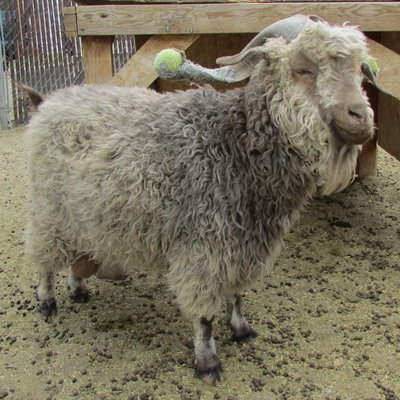
Baron the Angora herd sire.
Author Nicole Charshafian May 2014. Illustrations and Photographs by Yerazel and Yerani Charshafian.
Background
The Angora goat is from an area that was Angora Armenia (Asia Minor). They have been in existence since Biblical times. In the Bible Moses speaks of Mohair. The main use of Angoras is for their fiber called Mohair. They produce a luxurious soft fiber for spinning. (The fiber called Angora actually comes from Angora rabbits). The mohair is clipped or sheared twice a year on average producing 5lb per goat per shearing. The fiber grows on average 1in per month.
Mohair is a strong, elastic fiber with good luster and it dyes very well so has many uses in crafts, spinning, knitting and upholstering. Mohair is quite valuable because of its strength, beauty, and durability. Young animals with finer mohair are usually considered more valuable for mohair production.
Although their main purpose is fiber Angora breeders have worked to have the meat of Angora goats called Chevon and it is fairly available for eating and considered a delicacy.
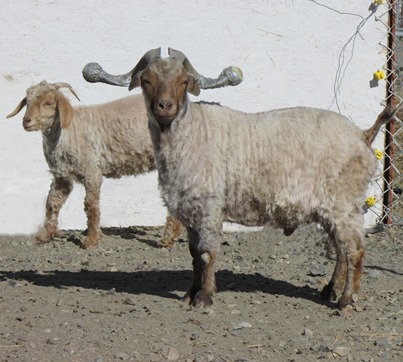
Baron and Nooshig at Desert Base just after shearing.
Physical Characteristics
Angora goats are smaller than sheep and the average milk goat but their size is quite varied. Bucks can weight between 180-220lb at 5yo and does 70-110lb. They are horned goats with the bucks growing large horns. The ears are medium size and considered pendulous though compared to other goats drooping might describe them better since they are held slighting up and away from their heads. They should have straight backs, deep and uniform bodies, deep chests, straight legs and the rear quarters should show good development.
Mohair grows in either ringlets or waves. The goats are usually classified by the type of mohair. Ringlet type goats are C Type, and the flat locked goats are B Type. The ringlet locks usually run the length of the mohair. The flat lock is usually wavy and more bulky in appearance.
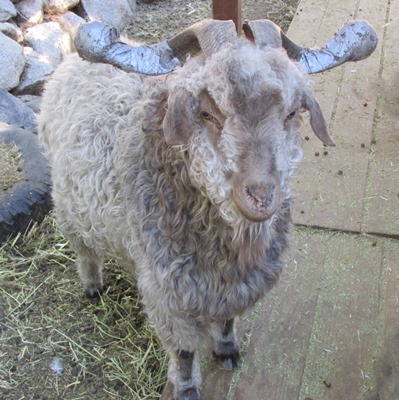
Baron with balls on his horns to protect people and other animals from injury.
Characteristics
The Angora goat is not as prolific breeders as other goats with only about a 60% kidding rate in large flocks. Single kids are usual.
The Angora can be more susceptible to parasites than other goats and sheep. They often carry an orange mite specific to them. Angoras are hardy in most climates but are vulnerable just after shearing. For three weeks after shearing they can succumb to colds and pneumonia if exposed to cold winds or rain/snow. Shearing is usually done in April and October with careful consideration of the weather. New born kids are also more frail than the average goat kid and need protection from adverse weather at first.
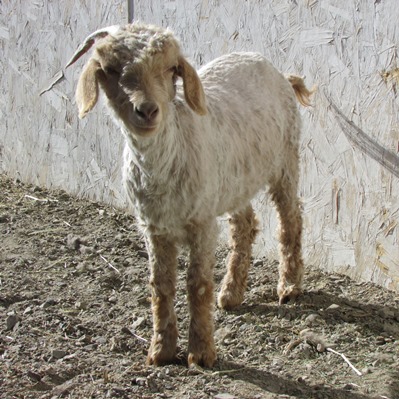
Nooshig our yearling Doe just after shearing.
Feeding
Goats are browsers which means they will eat forage as high as they can reach. Often times standing on back legs. The Angora is an effective browser and excellent at adapting to different environments. They are effective “brush clearers” or “weed eater”. Contrary to what people say goats DO NOT eat everything. They are quite selective with what they eat. They are very good at avoiding plants that are toxic to them. (which there are plenty of) Feeding good quality food is important to the health of your animals. While most goats will pick through the mold in “goat or cow” hay it is still not the best choice of food if something else is available. A good grass hay or hay and pellet combination is a good diet choice. Straight alfalfa is high in protein and can cause arthritis. For young kids, or lactating does more protein is needed. Kids suckle or are bottle fed for optimally 5months. Lactating Does may need grain supplements to sustain a healthy weight.
Housing
Goats need shelter. Although they are capable of handling extremes in weather they do need to be able to get out of the sun. An 8ft by 8ft shelter is adequate for a couple of goats. They are active when young and love to climb and jump so a corral with room (20ft x 20ft minimum) is needed. Things like tires and blocks to climb on keep them entertained are also good ideas. They like to sleep off the ground so a shelf is advisable in their enclosure. Since they are exceptional jumpers and climbers a 6ft fence is necessary.
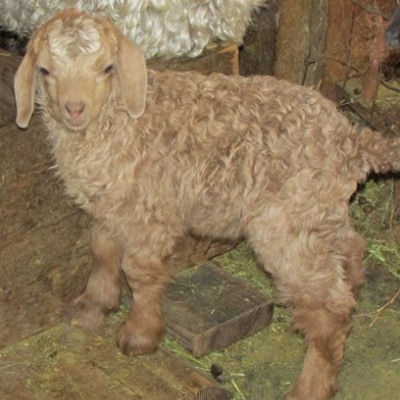
Nooshig as a young kid at Silver Lake Ranch, Mountain Base.
References
Australian Meat And Livestock Corp (authors) 1989 Handbook of Australian Livestock 3rd Edition Accessed May 2014
Briggs, Hilton M. 1969. Modern Breeds of Livestock. Third Edition, MacMillan Company http://www.ansi.okstate.edu/breeds/goats/angora/ accessed May 2014
Unknown Author 2008 Angoras Oklahoma state university http://www.ansi.okstate.edu/breeds/goats/angora/ accessed May 2014
Unknown Author 2011, The American Angora Goat Breeders Association Breed Standard For Angora Goats http://www.aagba.org/images/AAGBABreedStandard_110630.pdf accessed May 2014